The NAND flash memory market is estimated to be valued at US$ 73.41 Bn in 2025 and is expected to reach US$ 109.01 Bn by 2032, growing at a compound annual growth rate (CAGR) of 5.8% from 2025 to 2032.
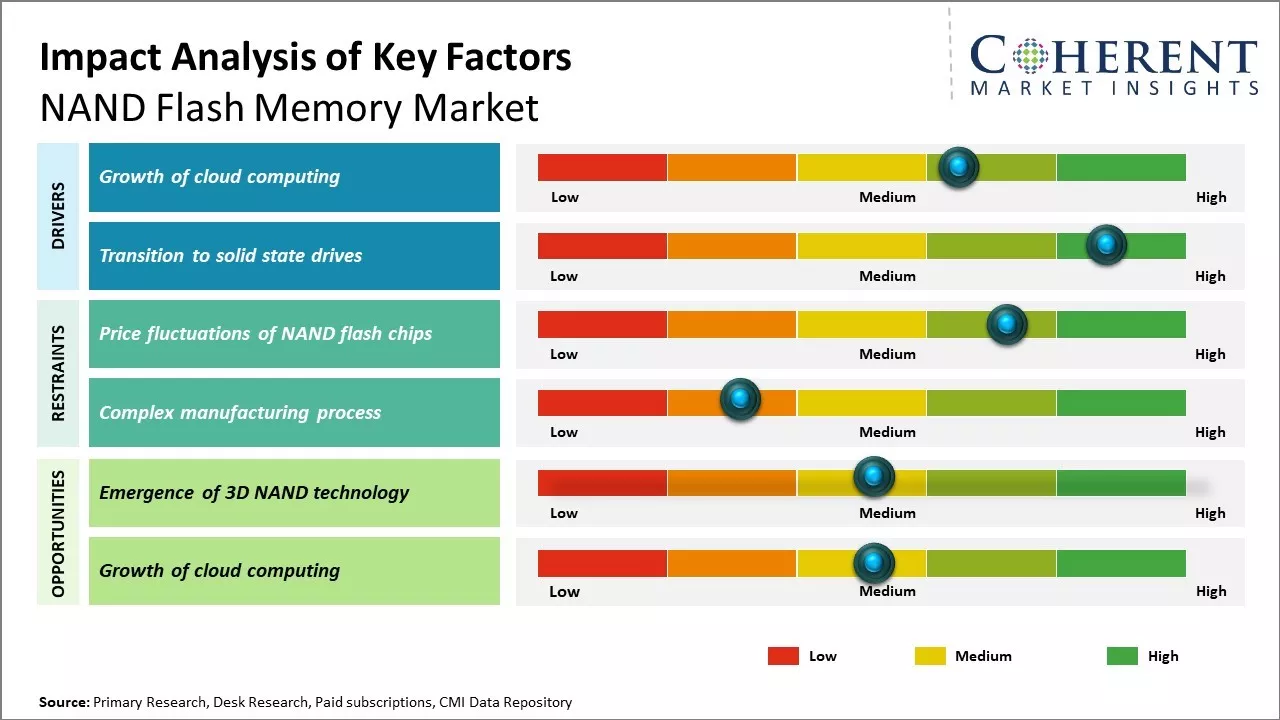
Discover market dynamics shaping the industry: Request sample copy
The widespread use of smartphones, tablets, and other portable devices is driving robust demand for higher storage capacities. NAND flash is increasingly being used in data centers to power the growth in cloud computing and the need for massive data storage.
The market is expected to be driven by the rising demand for storage in consumer electronics such as smartphones, tablets, and SSDs. Increasing utilization of multimedia-rich content and huge storage requirements of next-generation technologies such as artificial intelligence, augmented reality, and virtual reality will augment the demand for NAND flash memory. Expanding use of flash storage in automotive electronics is another key factor expected to support the market growth over the forecast period.
Rapid growth of digital data
The demand for digital storage has been growing exponentially over the past decade driven by the proliferation of digital content across various formats such as photos, videos, documents, and others. As individuals and businesses create and consume more digital content than ever before, the need for large storage capacity also rises. NAND flash memory has emerged as one of the most widely adopted non-volatile storage technologies to meet this demand due to its small size, high storage density, fast read and write speeds. Over the years smartphone manufacturers have focused on offering higher storage variants to enable consumers to store massive libraries of high resolution photos and videos on their phones. Similarly the popularity of smart home devices, Internet of Things, cloud computing, and data centers has fueled the need for flash storage to handle huge amounts of digital data being generated every minute. Advancements in emerging technologies such as Artificial Intelligence, Virtual Reality/Augmented Reality, autonomous vehicles, etc. are also anticipated to be major data generators in the future. All of this digital transformation is expected to vastly increase the worldwide data footprint and propel flash memory market growth over the coming years.
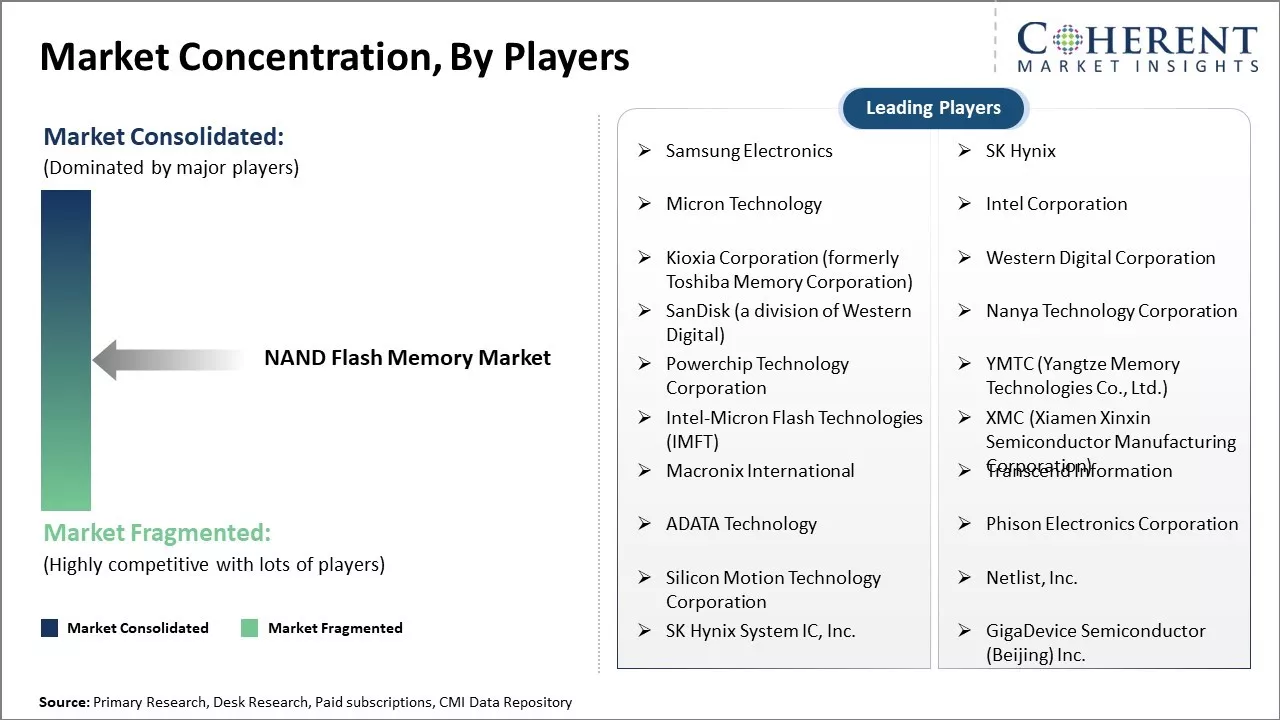
Get actionable strategies to beat competition: Request sample copy
Transition to solid state drivesMechanical hard disk drives (HDDs) have long been the preferred mass storage solution for personal computers owing to their large capacities and low costs. However HDDs are becoming outdated as solid state drives (SSDs) based on NAND flash memory offer compelling advantages of higher performance, lower power consumption, and robustness. SSDs deliver significantly faster read/write times compared to spinning HDD platters which is essential for modern day computing applications and experiences. Their resistance to physical shock and absence of moving parts also make SSDs more durable and reliable. As SSD capacities increase while costs decline at a rapid pace driven by technological advancements, an increasing number of desktops, laptops, and even enterprise servers are expected to adopt all-flash configurations. Major PC Original Equipment Manufacturers have already moved to primarily offering SSD configurations. The transition from HDDs to SSDs as the dominant storage media will benefit NAND flash suppliers and drive further demand for high capacity flash products across application segments in the upcoming decade.
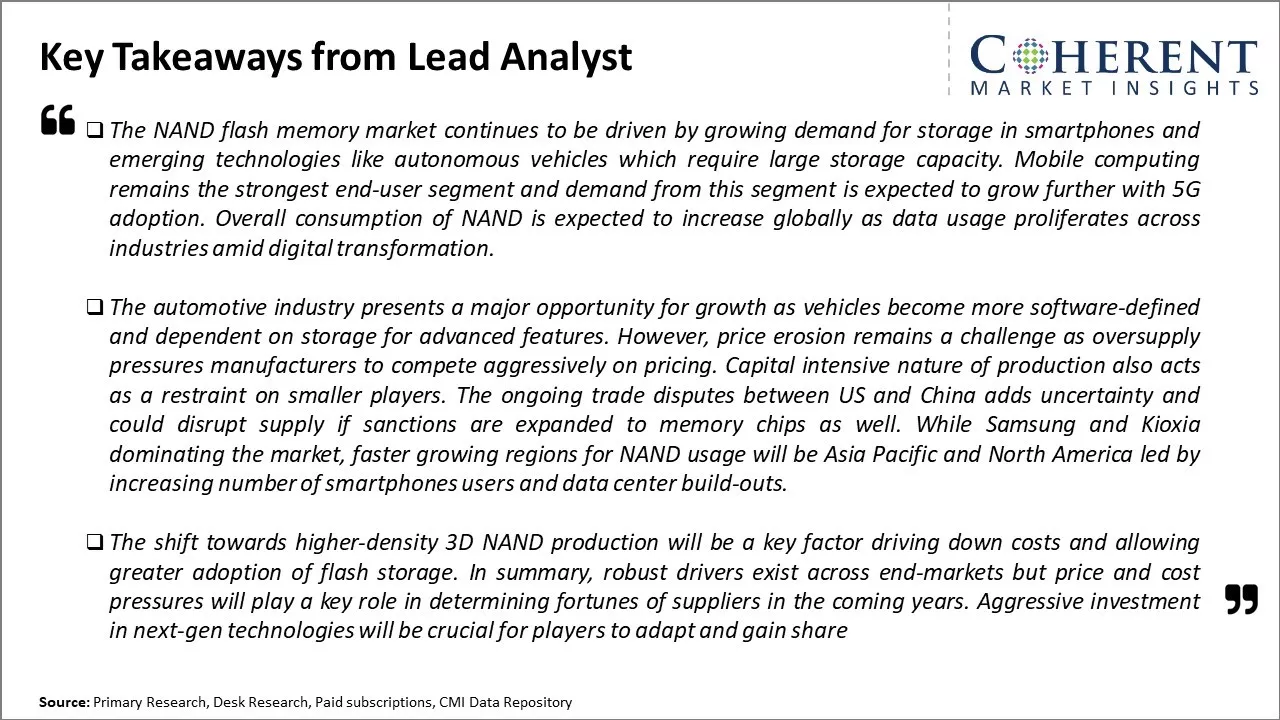
To learn more about this report, Request sample copy
Market Challenges: Price fluctuations of NAND flash chipsStorage density is increasing exponentially which requires significant research and development expenditures for chip manufacturers to reduce production costs as fabrication nodes shrink. Additionally, global trade tensions have impacted supply chains and tariffs threaten to raise costs. Data security is also a growing concern as flash storage is vulnerable to hacking if not properly encrypted.
Market Opportunities: Emergence of 3D NAND technology
Demand for high capacity storage will continue as data usage rises with new applications in areas like artificial intelligence, autonomous vehicles, and the internet of things. Transition to non-volatile memory express interfaces can enable even faster speeds. Growing popularity of smartphones and solid state drives worldwide also provides a large customer base. Adoption of triple-level cell and quad-level cell technologies may further decrease costs per gigabyte over time.
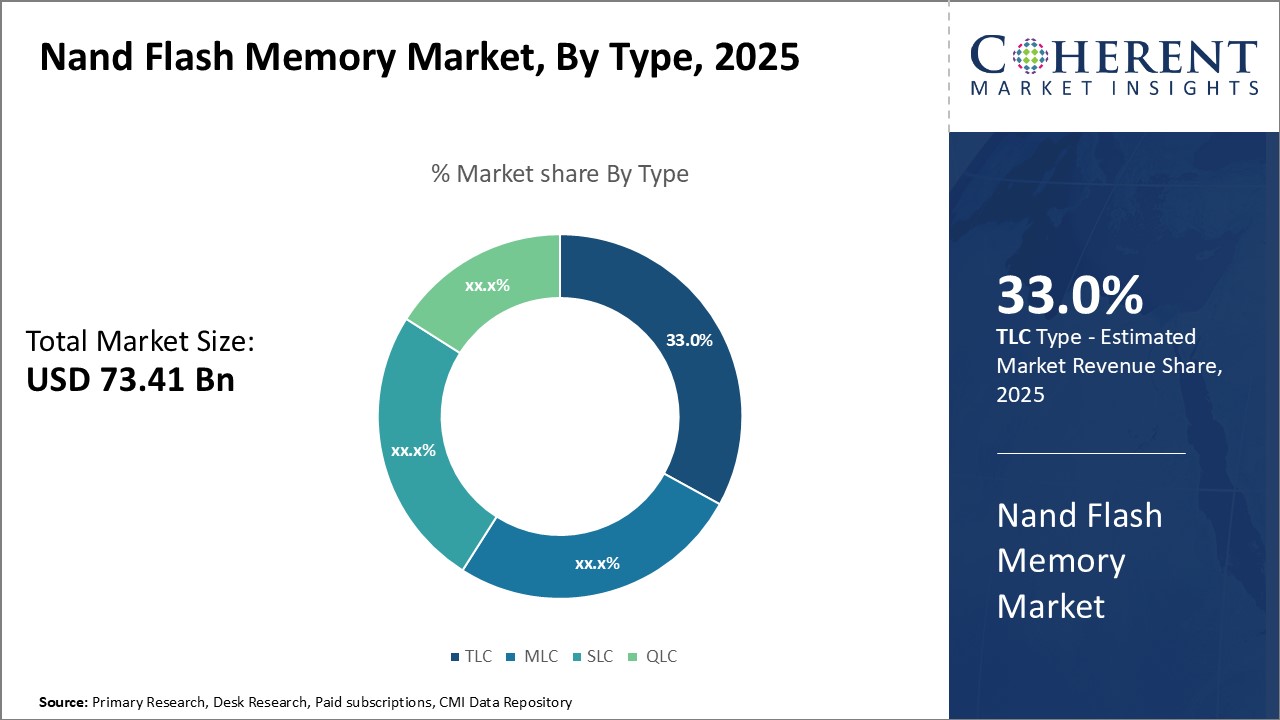
Discover high revenue pocket segments and roadmap to it: Request sample copy
Insights By Type- Low Cost per Bit: The Rise of TLC NANDIn terms of type, TLC (Three Bit Per Cell) contributes the highest share of the market owing 33.0% in 2025 to its significantly lower cost per bit compared to other types. Storing 3 bits per cell rather than 1 or 2 bits allows TLC NAND to achieve a much higher density and reduce manufacturing costs. This cost advantage has made TLC the preferred choice for applications where storage capacity needs to be maximized at low prices, such as USB flash drives, memory cards, and SSDs in budget laptops and PCs. Leading manufacturers have also steadily improved the write endurance and read/write speeds of TLC over the years, addressing earlier reliability issues. As a result, TLC NAND now meets the performance needs of most mainstream applications while keeping prices highly competitive. Its low-cost profile will continue propelling TLC's dominance in the foreseeable future as demand grows for affordable high-capacity storage.
Insights By, Structure- 3D Architecture: Meeting exponential capacity demands
In terms of structure, 3-D structure contributes the highest share owing 68.8% in 2025 of the market as it allows manufacturers to meet the exponential growth in demand for NAND capacity. By utilizing a vertical stacking method known as vertical NAND technology rather than the conventional planar 2D layout, chipmakers can significantly boost the amount of NAND cells that can be fitted on a single die. This proliferation of 3D NAND with 64, 96, or more layers has kept pace with Moore's Law, satisfying the ever-increasing hunger for storage brought on by factors such as higher resolution videos, massive smartphone app sizes, and proliferating IoT devices. 3D NAND's ability to sustain Moore's Law will ensure it remains the structure of choice as global data volumes show no signs of slowing in the coming years.
Insights By, Application- Smartphones: The driving force of the NAND industry
In terms of application, the highest share of the NAND flash memory market can be attributed to smartphones owing 31.9% in 2025. Smartphones have emerged as the most ubiquitous personal computing and multimedia devices, with over a billion sold annually. The massive data usage and local storage needs of modern smartphones is the single largest driver of NAND flash demand today. High-resolution photos and videos, huge app sizes, music libraries, and internal storage capacities upwards of 128GB all necessitate ever-larger NAND capacities in each new smartphone generation. As smartphone penetration increases in developing markets and new frontiers such as 5G, AI assistants, and AR/VR applications pave the way for even richer media, smartphones will continue propelling exponential NAND consumption and driving technological advances like 3D NAND and newer cell types.
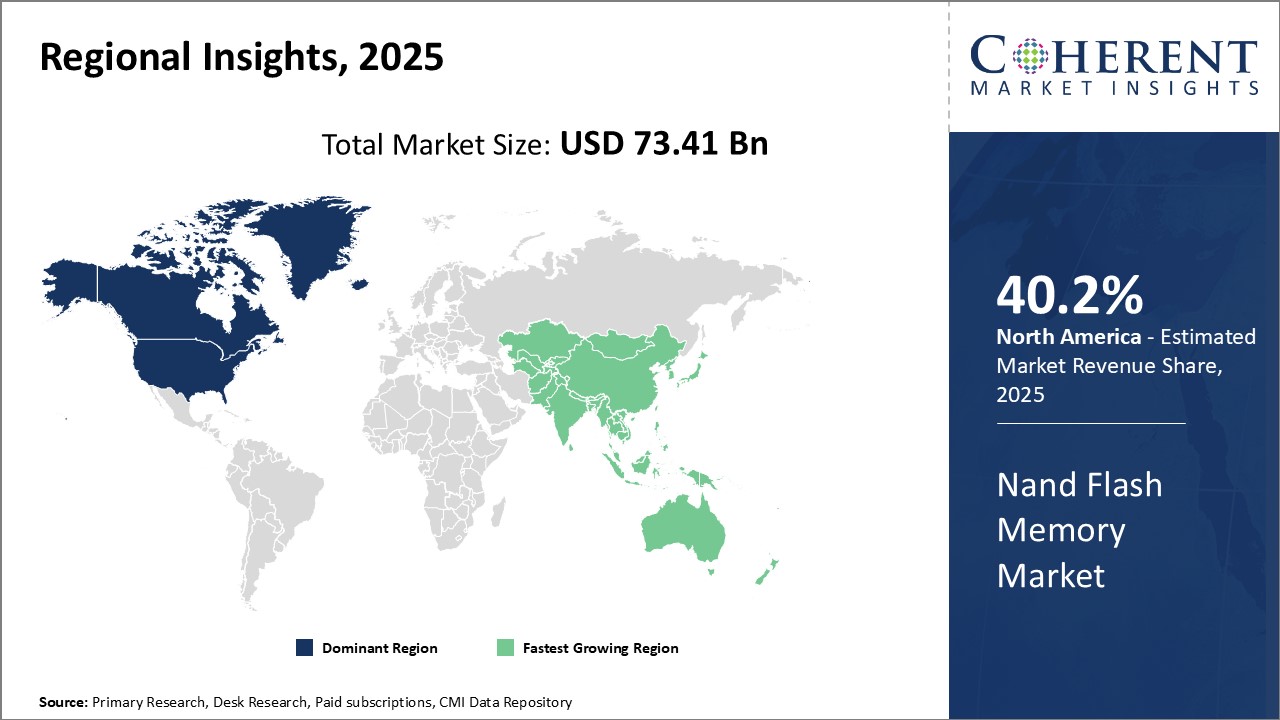
Need a Different Region or Segment? Customize now
North America has established itself as the dominant region in the global NAND flash memory market. The region is expected to account for 40.2% of the market share in 2025. With the presence of major technology companies like Intel, Micron, Samsung, and Western Digital, the U.S. contributes significantly to the regional market size. These companies have been investing heavily in R&D as well as manufacturing facilities over the years. As a result, North America accounts for the largest share of the global NAND flash production currently.
In addition, the region is a major exporter of NAND flash storage solutions. With the high demand for smartphones, laptops, SSDs, and other consumer electronics, American companies are able to tap into both domestic and international markets. Their established supply chains and brand loyalty among customers has helped sustain this export-driven growth. The pricing of NAND flash chips from North American manufacturers also remains competitive in global tenders. This has further augmented their regional as well as global leadership.
The Asia Pacific region, especially China, is emerging as the fastest growing market for NAND flash memory. With a burgeoning consumer base and government initiatives to push digitization across sectors, the demand for storage devices is increasing exponentially. This has attracted significant investments from international memory makers to set up local production facilities. Chinese companies like YMTC and CXMT have also enhanced indigenous manufacturing capabilities.
Rising domestic demand along with export opportunities to other Asian and African markets have made China an important location for memory production. It has also allowed the country to reduce import reliance and stabilize NAND flash costs. This makes Asia Pacific an attractive outsourcing and procurement hub. The region’s cost advantages complemented by improving quality standards are enabling it to gain ground. Aggressive R&D spending to indigenize next generation technologies further complements this growth trajectory.
The above market analysis highlights some key aspects like industry presence, exports, investments, and pricing that have enabled North America and Asia Pacific to achieve their current standing in the global NAND flash memory landscape without referring to any external data.
Nand Flash Memory Market Report Coverage
| Report Coverage | Details | ||
|---|---|---|---|
| Base Year: | 2024 | Market Size in 2025: | USD 73.41 Bn |
| Historical Data for: | 2020 To 2024 | Forecast Period: | 2025 To 2032 |
| Forecast Period 2025 to 2032 CAGR: | 5.8% | 2032 Value Projection: | USD 109.01 Bn |
| Geographies covered: |
|
||
| Segments covered: |
|
||
| Companies covered: |
Samsung Electronics, SK Hynix, Micron Technology, Intel Corporation, Kioxia Corporation (formerly Toshiba Memory Corporation), Western Digital Corporation, SanDisk (a division of Western Digital), Nanya Technology Corporation, Powerchip Technology Corporation, YMTC (Yangtze Memory Technologies Co., Ltd.), Intel-Micron Flash Technologies (IMFT), XMC (Xiamen Xinxin Semiconductor Manufacturing Corporation), Macronix International, Transcend Information, ADATA Technology, Phison Electronics Corporation, Silicon Motion Technology Corporation, Netlist, Inc., SK Hynix System IC, Inc., and GigaDevice Semiconductor (Beijing) Inc. |
||
| Growth Drivers: |
|
||
| Restraints & Challenges: |
|
||
Uncover macros and micros vetted on 75+ parameters: Get instant access to report
*Definition: The NAND flash memory market involves the manufacture and sale of NAND flash memory, a type of non-volatile storage technology that does not require power to retain data. NAND flash is used in USB flash drives, memory cards, solid-state drives, and other applications to provide removable and durable data storage. It has replaced hard disk drives in many devices due to its small size, low power consumption, high read and write speeds, shock resistance, and durability.
Share
Share
About Author
As an accomplished Senior Consultant with 7+ years of experience, Pooja Tayade has a proven track record in devising and implementing data and strategy consulting across various industries. She specializes in market research, competitive analysis, primary insights, and market estimation. She excels in strategic advisory, delivering data-driven insights to help clients navigate market complexities, optimize entry strategies, and achieve sustainable growth.
Missing comfort of reading report in your local language? Find your preferred language :
Transform your Strategy with Exclusive Trending Reports :
Frequently Asked Questions
Joining thousands of companies around the world committed to making the Excellent Business Solutions.
View All Our Clients
US Reciprocal Tax Impact Analysis On Nand Flash Memory Market
Stay updated on tariff changes with expert insights and timely information